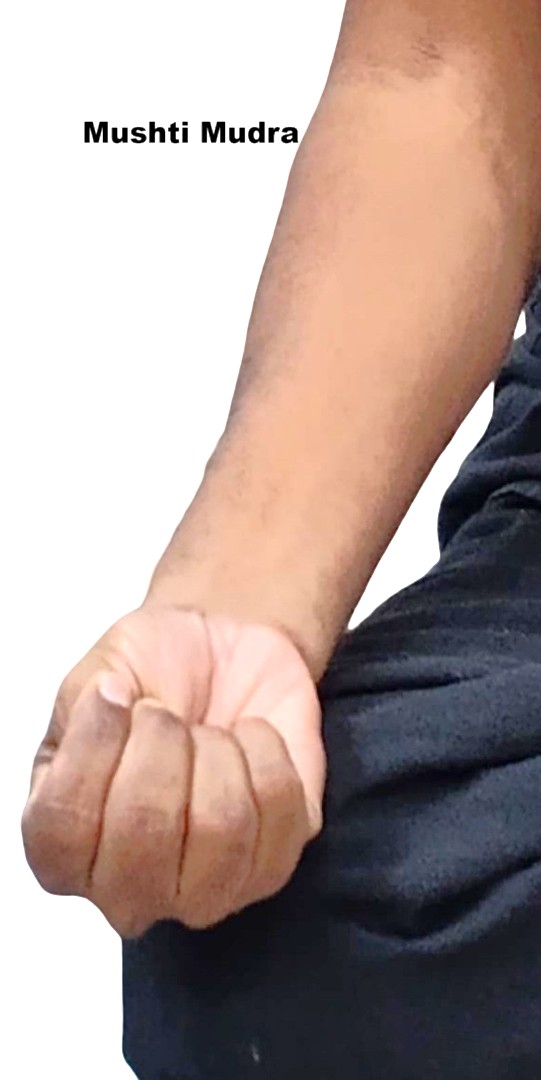Mushtika Mudrā
Introduction
Mushtika Mudrā is one of the classical hasta mudrās (hand gestures) found in yoga, Ayurveda, and Indian dance traditions. The word Mushtika literally means fist or clenched hand. This mudra embodies strength, stability, and the channeling of inner energy, and is often used to release physical and emotional tension stored in the hands and arms.
It is particularly important in both therapeutic yoga (hand mudra therapy) and dance (Natya Shastra tradition), where it represents actions like holding, grasping, or striking. In yoga therapy, Mushtika Mudra stimulates circulation, improves neuromuscular coordination, and helps release stress.
Meaning
Mushtika = fist, closed hand, symbol of strength and unity.
Mudra = seal, gesture, or psychic lock.
Symbolically, Mushtika Mudrā represents power, self-control, and inner holding together.
It also signifies hidden potential—just as the fist conceals strength within.
How to Perform Practice
Sit in a comfortable posture (Sukhasana, Vajrasana, or Padmasana).
Extend both arms forward at shoulder height.
Open the palms and spread the fingers wide.
Slowly close the fingers into a tight fist with thumbs wrapping over the other fingers.
Inhale deeply while opening the hands wide.
Exhale while closing the fists tightly (synchronizing breath with movement).
Continue for 10–15 rounds, then relax the hands on the knees.
Optionally, keep fists closed in front of the chest in a static mudra during meditation.
Benefits of Mushtika Mudrā
Physical Benefits
Strengthens fingers, wrists, and forearm muscles.
Improves grip strength and coordination.
Stimulates blood and lymphatic circulation in the arms.
Helps reduce arthritis stiffness, carpal tunnel tension, and hand fatigue.
Improves joint mobility of the hand and wrist.
Mental Benefits
Releases stored tension, frustration, and suppressed anger.
Provides a sense of inner control and empowerment.
Calms mental restlessness by channeling excess energy into the mudra.
Enhances focus and concentration during meditation.
Spiritual Benefits
Represents holding the prana (life-force) within the self.
Strengthens willpower and discipline.
Activates the Muladhara (root chakra) for grounding and stability.
Encourages self-confidence and courage.
Contraindications
Avoid over-clenching if suffering from severe arthritis, gout, or tendon injuries.
Those with recent fractures or sprains in the wrist/hand should consult a therapist before practice.
Should not be forced during episodes of extreme hypertension, as strong muscular contraction may elevate pressure.
Anatomy & Physiology
Engages the flexor digitorum profundus and superficialis, flexor pollicis longus, and intrinsic hand muscles.
The act of making and releasing the fist enhances venous return and lymphatic drainage.
Strengthens wrist stabilizers (flexors/extensors) useful in daily activities and sports.
Improves oxygenation in the forearm muscles, reducing fatigue.
Kinesiology
Involves flexion of metacarpophalangeal and interphalangeal joints.
Thumb action (over or under fingers) changes force distribution and grip pattern.
Repetitive dynamic practice creates isotonic contractions, while static holding creates isometric contractions.
Promotes hand-eye coordination and proprioceptive awareness.
Neurology
Activates mechanoreceptors and proprioceptors in the hand.
Stimulates the median and ulnar nerves, influencing the motor-sensory cortex of the brain.
Regular practice enhances fine motor control.
Psychologically, the fist gesture may release stored emotional energy (anger, fear, anxiety) by giving it symbolic expression.
Duration of Mudra
Dynamic version (opening/closing fists): 5–10 minutes daily.
Static version (holding fists in meditation): 2–15 minutes.
Can be practiced 2–3 times a day.
Counter Mudra
To balance Mushtika Mudra’s intensity:
Apana Vayu Mudra (Hridaya Mudra): for calming heart and emotions.
Chin Mudra: to bring openness and relaxation.
Anjali Mudra: to balance clenched energy with surrender.
Conclusion
Mushtika Mudrā is a simple yet powerful practice that combines physical strengthening, emotional release, and spiritual grounding. It supports hand and wrist health, enhances circulation, and provides a symbolic outlet for inner tension. By embodying the gesture of a fist, it teaches us to recognize, contain, and redirect our inner energy consciously. Practiced with awareness, it becomes both a therapeutic and meditative tool.
FAQ
Q1. Is Mushtika Mudra good for arthritis?
Yes, when practiced gently, it can improve flexibility and blood flow in arthritic hands.
Q2. Can it help with stress?
Yes, clenching and releasing the fists is an effective way to discharge anger and stress.
Q3. Does it improve grip strength?
Yes, it directly strengthens fingers, hands, and forearms.
Q4. Can I do it during meditation?
Yes, the static version can be held during meditation for grounding.
Q5. Which chakra does it influence?
Primarily the Muladhara (Root Chakra), connected to stability and grounding.
References
Swami Satyananda Saraswati, Asana, Pranayama, Mudra, Bandha.
Gertrud Hirschi, Mudras: Yoga in Your Hands.
Joseph Le Page & Lilian Aboim, Mudras for Healing and Transformation.
Natyashastra (classical dance mudras references).
B. K. S. Iyengar, Light on Yoga.
